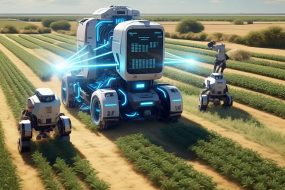
Multi-agent systems (MAS) are a type of artificial intelligence (AI) that involves the interaction of multiple autonomous agents to achieve a common goal. These agents can be software programs, robots, or even humans, and they work together to solve complex problems, make decisions, and adapt to changing environments.
What are Multi-Agent Systems?
Multi-agent systems are composed of multiple agents that interact with each other and their environment to achieve a common goal. These agents can be heterogeneous, meaning they have different capabilities, goals, and behaviors. MAS can be used in a wide range of applications, including:
- Robotics: MAS can be used to control and coordinate the actions of multiple robots to achieve a common goal, such as search and rescue missions or manufacturing tasks.
- Smart Grids: MAS can be used to manage and optimize the distribution of energy in smart grids, taking into account factors such as energy demand, supply, and pricing.
- Transportation Systems: MAS can be used to optimize traffic flow, manage traffic signals, and coordinate the actions of multiple vehicles to reduce congestion and improve safety.
Key Characteristics of Multi-Agent Systems
MAS have several key characteristics that distinguish them from other types of AI systems. These include:
- Autonomy: Agents in a MAS are autonomous, meaning they can make decisions and take actions without human intervention.
- Decentralization: MAS are decentralized, meaning that there is no central controller or decision-maker. Instead, agents make decisions based on their local environment and interactions with other agents.
- Interoperability: Agents in a MAS can interact with each other and their environment, exchanging information and coordinating their actions.
Real-World Examples of Multi-Agent Systems
There are many real-world examples of MAS in use today. Some examples include:
- Google’s Self-Driving Cars: Google’s self-driving cars use a MAS to navigate and interact with their environment, including other cars, pedestrians, and traffic signals.
- Amazon’s Warehouse Robots: Amazon uses a MAS to manage and coordinate the actions of thousands of robots in its warehouses, optimizing the picking and packing of orders.
- IBM’s Watson: IBM’s Watson is a MAS that uses natural language processing and machine learning to answer questions and provide recommendations to users.
Benefits and Challenges of Multi-Agent Systems
MAS have many benefits, including:
- Improved Efficiency: MAS can optimize processes and improve efficiency by automating tasks and coordinating the actions of multiple agents.
- Increased Flexibility: MAS can adapt to changing environments and respond to unexpected events, making them more flexible and resilient than traditional AI systems.
- Enhanced Decision-Making: MAS can make decisions based on the collective knowledge and experience of multiple agents, leading to better decision-making and problem-solving.
However, MAS also have several challenges, including:
- Complexity: MAS can be complex and difficult to design and implement, requiring significant expertise and resources.
- Scalability: MAS can be difficult to scale, as the number of agents and interactions increases, making it harder to manage and optimize the system.
- Security: MAS can be vulnerable to security threats, such as hacking and data breaches, which can compromise the integrity and reliability of the system.
Conclusion
In conclusion, multi-agent systems are a powerful and flexible technology that can be used to solve complex problems and improve decision-making. While they have many benefits, they also have several challenges that must be addressed. As the field of AI continues to evolve, we can expect to see more widespread adoption of MAS in a variety of applications, from robotics and smart grids to transportation systems and healthcare.
For more information on multi-agent systems, I recommend checking out the following resources:













